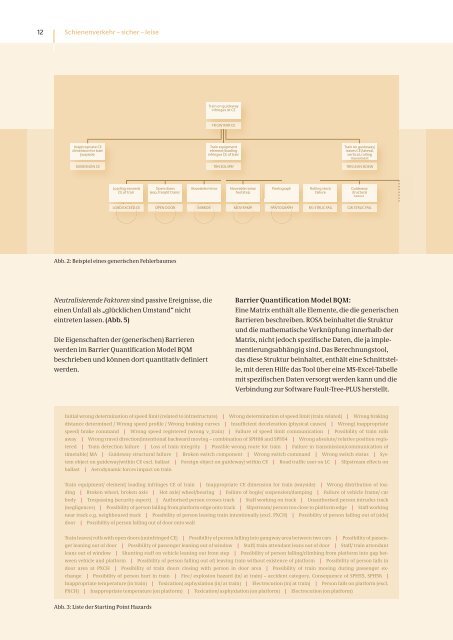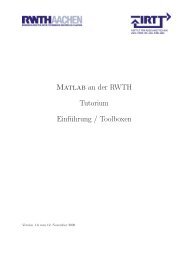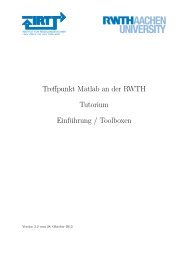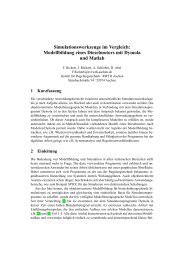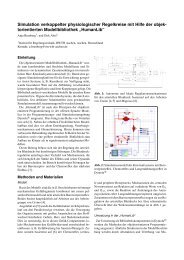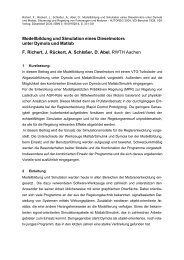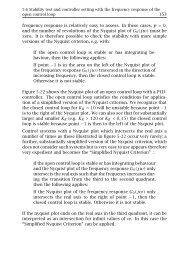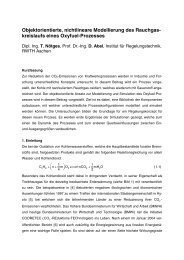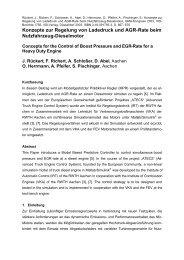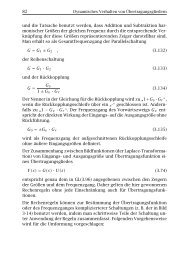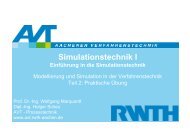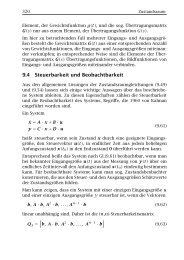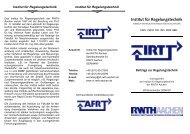Schienenverkehr – sicher, leise, effizient - (IRT) der RWTH Aachen
Schienenverkehr – sicher, leise, effizient - (IRT) der RWTH Aachen
Schienenverkehr – sicher, leise, effizient - (IRT) der RWTH Aachen
Erfolgreiche ePaper selbst erstellen
Machen Sie aus Ihren PDF Publikationen ein blätterbares Flipbook mit unserer einzigartigen Google optimierten e-Paper Software.
12<br />
<strong>Schienenverkehr</strong> <strong>–</strong> <strong>sicher</strong> <strong>–</strong> <strong>leise</strong><br />
Inappropriate CE<br />
dimension for train<br />
(wayside)<br />
DIMENSION CE<br />
Loading exceeds<br />
CE of train<br />
Abb. 2: Beispiel eines generischen Fehlerbaumes<br />
Neutralisierende Faktoren sind passive Ereignisse, die<br />
einen Unfall als „glücklichen Umstand“ nicht<br />
eintreten lassen. (Abb. 5)<br />
Die Eigenschaften <strong>der</strong> (generischen) Barrieren<br />
werden im Barrier Quantifi cation Model BQM<br />
beschrieben und können dort quantitativ defi niert<br />
werden.<br />
Abb. 3: Liste <strong>der</strong> Starting Point Hazards<br />
Open doors<br />
(esp. freight trains)<br />
Barrier Quantifi cation Model BQM:<br />
Eine Matrix enthält alle Elemente, die die generischen<br />
Barrieren beschreiben. ROSA beinhaltet die Struktur<br />
und die mathematische Verknüpfung innerhalb <strong>der</strong><br />
Matrix, nicht jedoch spezifi sche Daten, die ja implementierungsabhängig<br />
sind. Das Berechnungstool,<br />
das diese Struktur beinhaltet, enthält eine Schnittstelle,<br />
mit <strong>der</strong>en Hilfe das Tool über eine MS-Excel-Tabelle<br />
mit spezifi schen Daten versorgt werden kann und die<br />
Verbindung zur Software Fault-Tree-PLUS herstellt.<br />
Initial wrong determination of speed limit (related to infrastructure) | Wrong determination of speed limit (train related) | Wrong braking<br />
distance determined / Wrong speed profi le / Wrong braking curves | Insuffi cient deceleration (physical causes) | Wrong/ inappropriate<br />
speed/ brake command | Wrong speed registered (wrong v_train) | Failure of speed limit communication | Possibility of train rolls<br />
away | Wrong travel direction/intentional backward moving <strong>–</strong> combination of SPH08 and SPH14 | Wrong absolute/ relative position regis-<br />
tered | Train detection failure | Loss of train integrity | Possible wrong route for train | Failure in transmission/communication of<br />
timetable/ MA | Guideway structural failure | Broken switch component | Wrong switch command | Wrong switch status | Sys-<br />
tem object on guideway/within CE excl. ballast | Foreign object on guideway/ within CE | Road traffi c user on LC | Slipstream effects on<br />
ballast | Aerodynamic forces impact on train<br />
Train equipment/ element/ loading infringes CE of train | Inappropriate CE dimension for train (wayside) | Wrong distribution of loa-<br />
ding | Broken wheel, broken axle | Hot axle/ wheel/bearing | Failure of bogie/ suspension/damping | Failure of vehicle frame/ car<br />
body | Trespassing (security aspect) | Authorised person crosses track | Staff working on track | Unauthorised person intrudes track<br />
(negligences) | Possibility of person falling from platform edge onto track | Slipstream/ person too close to platform edge | Staff working<br />
near track e.g. neighboured track | Possibility of person leaving train intentionally (excl. PXCH) | Possibility of person falling out of (side)<br />
door | Possibility of person falling out of door onto wall<br />
Train on guideway<br />
infringes ist CE<br />
TR GW INFR CE<br />
Train equipment<br />
element/loading<br />
infringes CE of train<br />
TRN EQUIPM<br />
Moveable mirror Moveable ramp/<br />
footstep<br />
Pantograph Rolling stock<br />
failure<br />
Train leaves/ rolls with open doors (uninfringed CE) | Possibility of person falling into gangway area between two cars | Possibility of passen-<br />
ger leaning out of door | Possibility of passenger leaning out of window | Staff/ train attendant leans out of door | Staff/ train attendant<br />
leans out of window | Shunting staff on vehicle leaning out from step | Possibility of person falling/climbing from platform into gap bet-<br />
ween vehicle and platform | Possibility of person falling out of/ leaving train without existence of platform | Possibility of person falls in<br />
door area at PXCH | Possibility of train doors closing with person in door area | Possibility of train moving during passenger ex-<br />
change | Possibility of person hurt in train | Fire / explosion hazard (in/ at train) <strong>–</strong> accident category, Consequence of SPH55, SPH56 |<br />
Inappropriate temperature (in train) | Toxication/ asphyxiation (in/ at train) | Electrocution (in/ at train) | Person falls on platform (excl.<br />
PXCH) | Inappropriate temperature (on platform) | Toxication/ asphyxiation (on platform) | Electrocution (on platform)<br />
Train on guideway/<br />
leaves CE (lateral,<br />
vertical, rolling<br />
movement<br />
TRN LEAN SIDEW<br />
Guideway<br />
structural<br />
failure<br />
LOAD EXCEED CE OPEN DOOR MIRROR MOV RAMP PANTOGRAPH RS: STRUC FAIL GW STRUC FAIL


